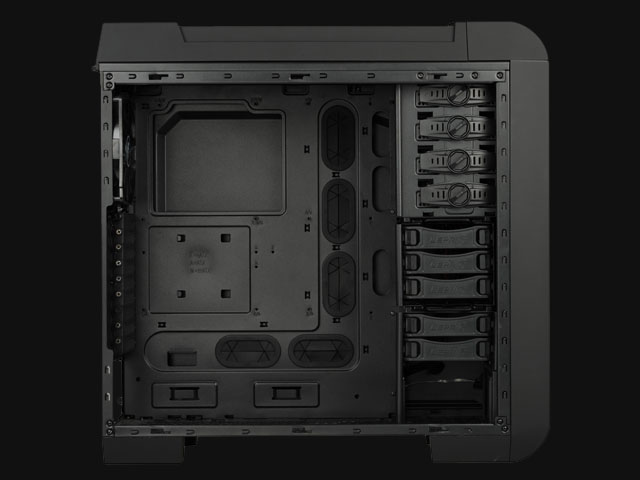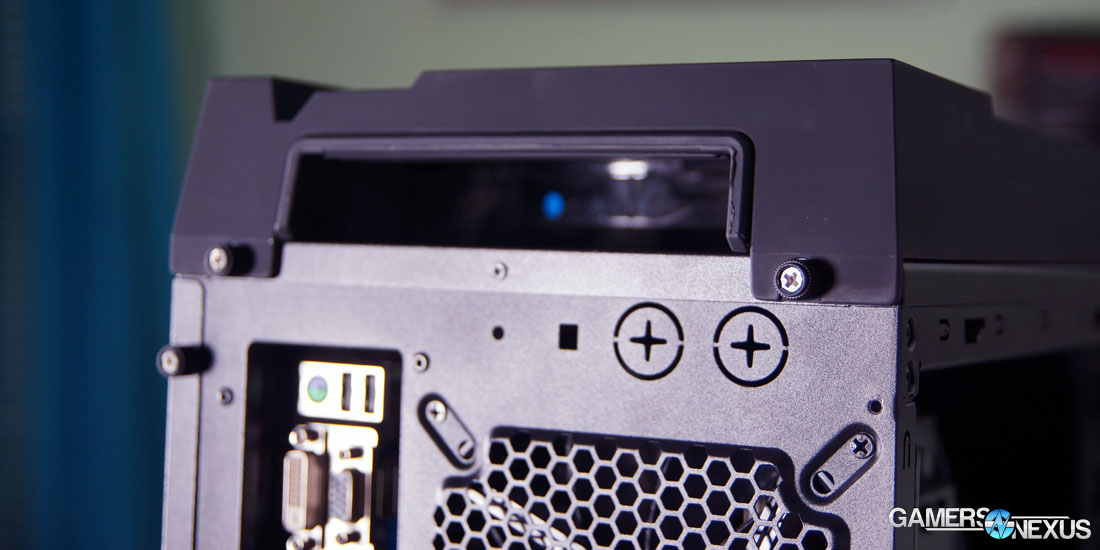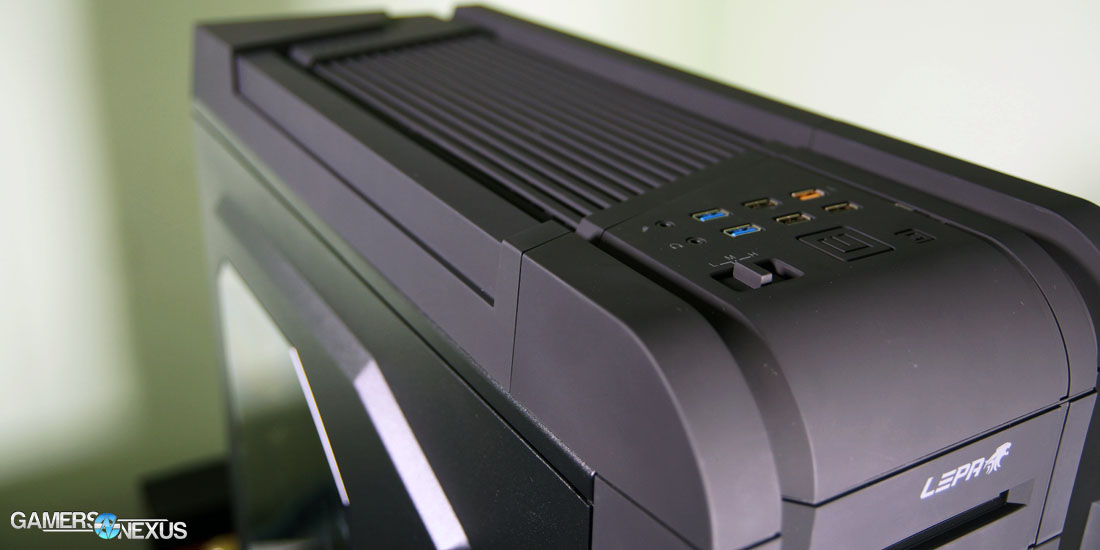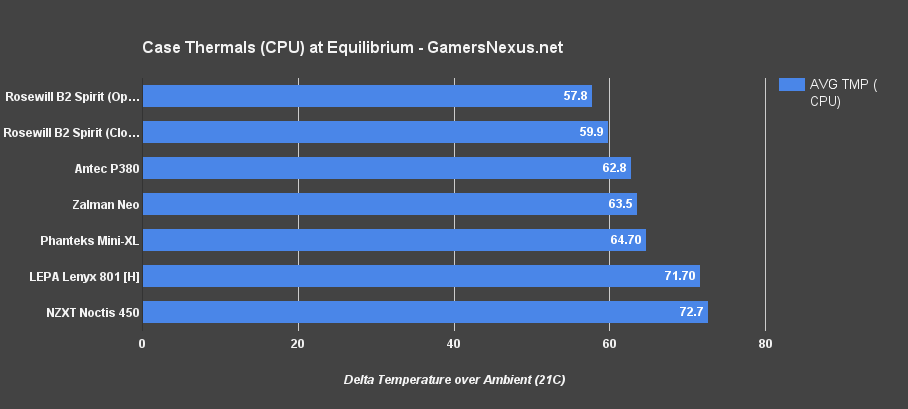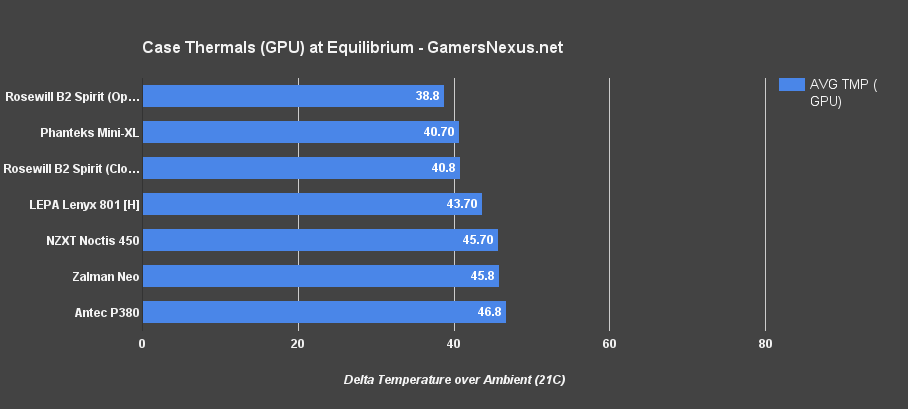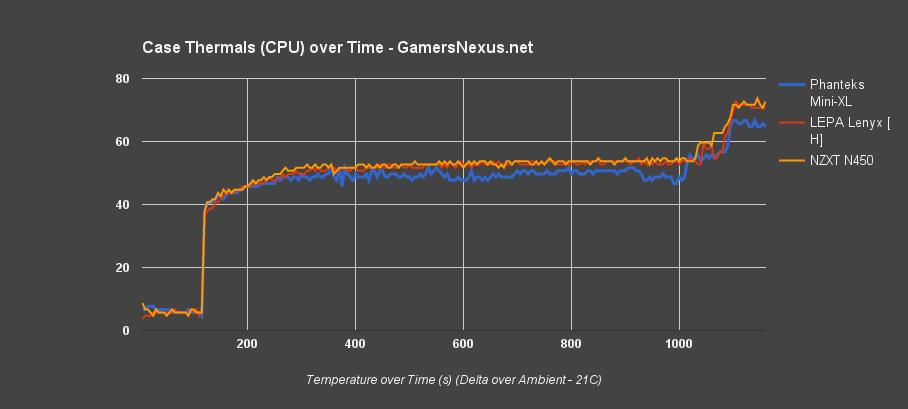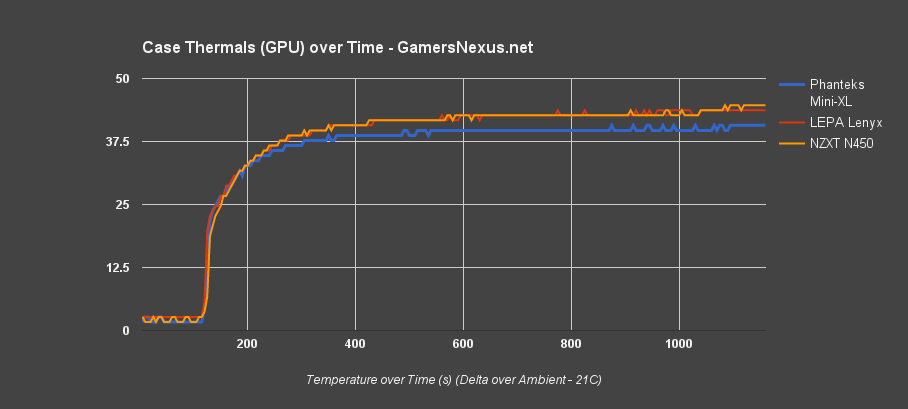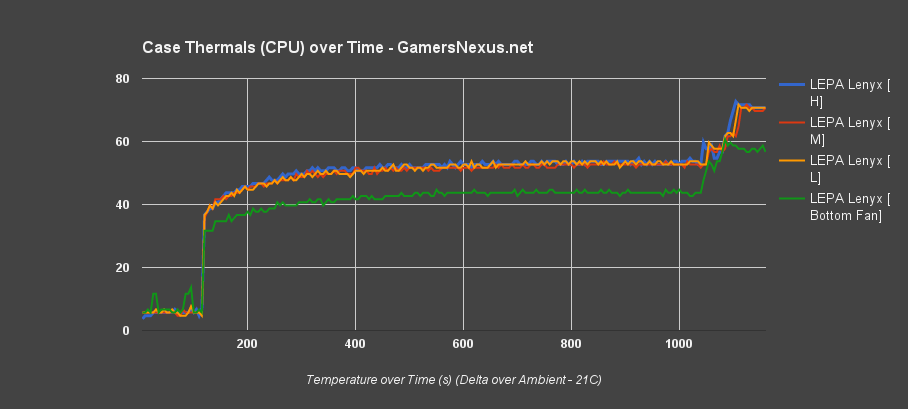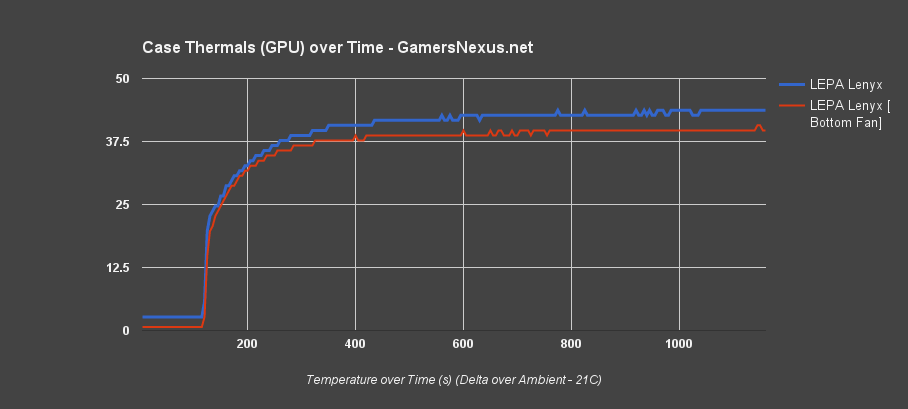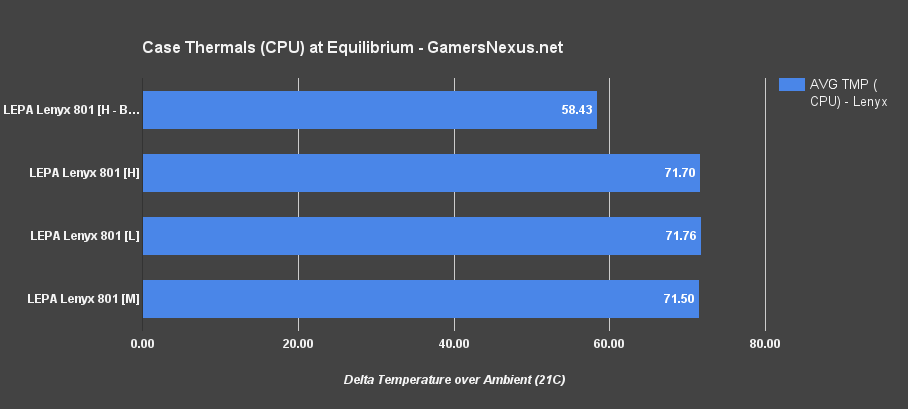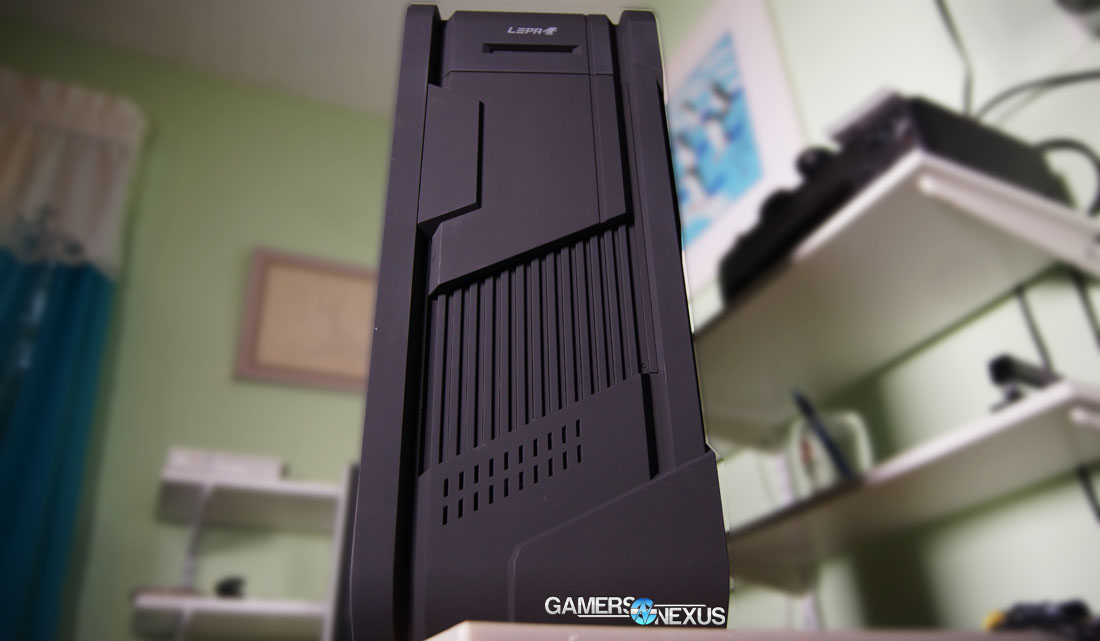Enermax, LEPA, and Ecomaster are all confusingly tied together in a web of brands and companies, but they can be effectively thought of as a single entity. We were recently offered the new LEPA “Lenyx” case for review, a $160 E-ATX full-tower unit that uses a rubberized paint aesthetic.
In response to the offer, I warned the company that I may dislike the case based on an initial product overview. From my quick preview, I advised, it looked as if the case made heavy use of plastics, something I've grown to dislike over the years. The Enermax representative assured me that the photos didn't do the enclosure justice, emphasizing the high-quality application of rubberized paint and again offering the unit for review. I accepted.
This review of the LEPA Lenyx full-tower looks at ease-of-installation, build quality, aesthetics, extras, and thermal performance in benchmarking. We'll also go over cable management and design strategy. The LEPA 801 Lenyx case has an MSRP of $160 and is presently sold at $171 via Amazon.
Starting with the specs:
LEPA Lenyx Full-Tower Specs
| Model | LPC801A-B |
| Color | Black only |
| Board Support | E-ATX, ATX, mATX |
| Front I/O | 1x USB Charger 2x USB3.0 2x USB2.0 HD Audio Fan Controller |
| Drives & Expansion | 3x 5.25" 5x 3.5/2.5" 1x 5.25 -> 3.5" 1x 2.5" SSD behind board tray 1x 2.5" SSD hot-swap front 2x 2.5" with 5.25" adapter 9x Expansion |
| Cooling | Pre-installed: Front: 1x 200mm w/ blue LED Top: 1x 200mm w/ blue LED Rear: 1x 140mm Optional: 2x120mm bottom |
| Radiator Support | Bottom: 120, 240mm Top: 120, 240, 280, 360mm Back: 120, 140mm Front: none |
| Clearance | GPU: 360mm, 490mm w/o HDD cage CPU: 194mm |
| Dimensions | 250 x 558 x 576mm (WHD) |
| Price | $160 |
The plain specs are pretty simple, but LEPA adds a couple of extras that are more worthy of note. Covering the basics, the fan ships with three pre-installed fans: 1x 140mm rear, 1x 200mm front, 1x 200mm top, and space for expansion in the bottom (1x 120mm realistically, though 2x 120mm advertised).
Liquid cooling is supported up to 140mm in the rear, 360mm in the top, and up to 140mm in the bottom – though mounting in the bottom would be primarily for a GPU radiator.
In terms of extras, the LEPA Lenyx tower hosts a “super-charger” USB port, headset hanger, hot-swap SATA port, and fan controller.
The super-charger USB port increases delivered amperage to mobile devices considerably, pushing 2.4A. For reference, my phone's charger – a Moto X – pushes 1.2A. Doubling the amperage diminishes charging time, but it does so with downsides. Pushing higher amperage through a Li-ion battery will result in a weaker charge with less staying power (consumption is faster). This also impacts the long-term viability of the battery and is aggressive on the Li-ion cells. We recommend only using “super-charger” ports when desperate for juice and on short notice. The super-charger port is marked with an orange header.
A magnetic headset holder is a welcomed inclusion with the LEPA case and clings to the side of the enclosure.
The hot-swap SATA port protrudes from the front of the chassis – potentially a hazard to less-than-careful individuals – and allows for immediate connection of internal SSDs for storage. It's not necessarily a common use case, but one that we step through regularly in the lab where storage is passed around.
The fan controller steps power assignment in three levels (low, medium, high) to the fans, impacting speed and brightness of the LEDs.
LEPA Lenyx Look & Feel
LEPA's Lenyx case is embellished with soft-grip rubber plastic paneling front-and-top, but uses more standard steel side panels. The case ships only in black, though the side panels and rubber-coated top and front panels differ in color depth. This is a common issue we've seen with cases that deploy differing materials for the side panels; because the soft-grip rubber generates a uniquely matte and gray-black appearance, the black-coated metal is darker and more light-reflective. It's not a big deal and is hardly noticeable to any but the most neurotic users, once built, but is something worth highlight. The only real way to avoid this is to ditch the soft-grip coating, something that we actually ended up liking.
The top panel is slotted for air exhaust, offering enough clearance above the frame to support most radiators. Radiator fans can be installed below the frame without interfering too heavily with cable routing.
Enermax took some steps to improve the portability of their large case by adding a steel handle to the rear, strategically located under the top panel and encased in a rubber grip. This makes for comfortable, easy movement of the case without risking damage to the paneling. With most cases, carrying the entire system by its plastic top or front panels can inflict damage (ripping the alligator clips out, mostly). Enermax's clever inclusion of a handle bypasses this. The company's decision to encase the handle in a rubberized grip further demonstrates attention to detail.
Split into a three-quarters and a one-quarter section, the top panel breaks free from the chassis in two chunks: Top-rear and top-IO. The top-rear panel is locked-in by two thumb-screws and mounted to rails, a non-standard assemblage that makes for trivial removal of the panel. This eases radiator and top-fan installation or changes, and is something I sincerely hope more cases will adopt. The front section is mounted by alligator clips and plastic and, sadly, is easily broken (as we found out). Most users will never have to remove this section of the enclosure, so it's primarily a non-issue; for those who do remove it, exercise extreme caution and apply a minimal amount of downward force to prevent destroying the plastic clips. The top-front panel is used strictly to house the fan controller PCB, I/O PCB, and cabling.
The rubberized finish is an expensive one and is a big contributor to the premium $160 MSRP. The coating eliminates the cheap plastic feel that plagues cases with similar paneling designs – so that's a plus – and feels smooth to the touch. As a bonus, the material is fairly resilient to both fingerprints and scratches, something we found untrue of the Noctis 450.
LEPA Lenyx Priorities & Cable Management
Cable management in the LEPA 801 Lenyx case is easy – but the art of cable routing has become ubiquitous since the days of the Antec 900. Nothing quite comes close to NZXT's S340 when it comes to cable management.
Enermax gets a few things right where it counts: Cable management pass-throughs exist on the far perimeter of the board tray, ensuring larger ATX boards (ASUS Rampage IV, for example) and E-ATX boards can be cabled; cut-outs in the board tray allow for vertical pass-through of CPU power cables; behind-the-tray routing is deep (aided by the bezeled side panel), ensuring no destruction of SATA connectors when the doors are sealed.
I do wish that Enermax had an additional (fourth) cable pass-through for CPU power, though. This is something that a lot of companies miss, the exceptions generally being NZXT and Corsair. Enermax has a cut-out on the far left and far right, but none in between. Some motherboards – again, the ASUS Rampage IV as an example – have 8 to 12 pins of juice located due north of the CPU socket. The current layout forces awkward routing at sub-optimal angles to cable such a configuration.
Enermax has a few other small, but important features to aid installation. A cut-out on the left support beam of the chassis allows for head-on contact of the screwdriver to the expansion slot screws, an oversight on numerous cases. This ensures the user is not at risk of cross-threading an expansion slot.
Continue to Page 2 for in-depth thermal benchmarks.
Case Testing Methodology
We tested using our updated 2015 case test bench, detailed in the table below. Our thanks to supporting hardware vendors for supplying some of the test components.
Conducting thermal tests requires careful measurement of temperatures in the surrounding environment. We control for ambient – which is set to a constant 21C – and then produce charts using a Delta T(emperature) over Ambient value. This value subtracts 21C from the measured output, producing a delta report of thermals. AIDA64 is used for logging thermals of semiconductor components.
All case fans are manually configured to their maximum throughput using BIOS. This forces testing of case fan performance in addition to the case's air channeling and airstream design. This also ensures minimal variance when testing, as automatically controlled fan speeds can reduce reliability of benchmarking. The CPU fan is set to use a custom fan curve that was devised in-house after a series of testing; setting the CPU fan to its maximum speed can limit the disparity shown from case-to-case as the CPU cooler is extremely efficient, and will create a ceiling for thermal performance if bottlenecked.
| GN Case Test Bench 2015 | Name | Courtesy Of | Cost |
| Video Card | ASUS | $210 | |
| CPU | Intel i-4770K CPU | CyberPower | $340 |
| CPU Cooler | Be Quiet! Dark Rock 3 | Be Quiet! | $60 |
| Memory | HyperX Genesis 2x4GB | Kingston Tech. | $70 |
| Motherboard | ASRock Z97 Micro-ATX | GamersNexus | $100 |
| Power Supply | Be Quiet Dark Power Pro | Be Quiet! | $200 |
| SSD | Samsung 840 EVO | CyberPower | $140 |
| Case | This is what we're testing! | - | - |
The video card is configured to run at 55% fan speed at all times. Stock clocks are used. We employ an ASUS Strix GTX 960 (~$200) for the case test bench when using more budget-class cases. Additional SLI and high-end, high-heat cards are used when conducting testing on more expensive (higher-end) cases.
Prior to load testing, we collect idle temperature results for ten minutes to determine the unloaded cooling performance of a case's fans and air channels. Thermal benchmarking is conducted for twenty minutes, a period we've determined sufficient for achieving equilibrium. The over-time data is aggregated and will occasionally be compiled into charts, if interesting or relevant. The equilibrium performance is averaged to create the below charts.
Load testing is conducted using Prime95 LFFTs and Kombustor stress testing simultaneously.
LEPA Lenyx Thermals at Equilibrium
Measured at equilibrium – the stabilization of thermals after a 20 to 25-minute burn-in – we see that the Lenyx performs marginally better than the N450, but underperforms compared to the (slightly more expensive) Phanteks Mini-XL. The Phanteks case holds a substantial ~5C lead in CPU thermals and ~3C lead in GPU thermals.
None of these temperatures are particularly bad, though both NZXT and LEPA have room for improvement. As we continue to add cases to our growing thermal benchmark, we should see what airflow-focused cases are capable of doing.
LEPA Lenyx Thermals over Time
Cases are fairly consistent. Measured over time using automated execution of system loading, we see that the LEPA Lenyx case runs warm when compared to the Phanteks Mini-XL, but is about on-par with the (known-warm) NZXT Noctis 450.
There's nothing particularly interesting here for the Lenyx case. Its temperature rise over the test cycle is representative of most cases. The lower RPM of the fans – although they are larger – is to blame for the slight delay in cool-down ability once the burn-in starts (see the spike in the OT chart). The Lenyx's somewhat warm thermals are primarily attributable to the thick plastic cross-bars in front of the intake and exhaust meshings.
We also noticed a relatively loud dBA output of low-frequency humming emitted from the rear fan. If we were to perform frequency spectrum analysis, the Lenyx would have the highest dB output in the ~100Hz range. A simple solution to this issue was to place a hand over the meshed exhaust port. LEPA could eliminate this noise by utilize a fan with a better slipstream to ensure air does not get trapped when attempting to exit the case.
Fan Controller Tests & Adding One Fan
This is something we're trying to do for some cases tests going forward. We normally test fan controllers, but in this case, we also wanted to test the impact of adding a single fan to the system. Cases always advertise how many fans can be added, so it makes sense to try and exploit those options. For the Lenyx, we opted to add a single bottom intake fan (120mm @ 1100RPM) to observe the impact to performance. The difference is somewhat profound:
There's a 3C GPU cooling jump with the bottom fan. More noticeable is the ~14C performance improvement for CPU thermals. A bottom fan has a core advantage unique to its deployment: Because of the stack effect, air closer to the floor will be cooler than air higher up. A bottom intake fan also avoids the concern of intaking already-heated exhaust, which will be directed upward by the laws of physics. LEPA's case has a considerable amount of clearance from the ground with its high feet, ensuring high airflow for bottom intake. This would be the one place we'd add a fan and feels like a potential oversight by LEPA, given the massive performance gains.
We also revealed that the Lenyx operates at effectively identical thermals across all three fan settings. We attribute this to the limited intake capabilities of the enclosure to begin with, coupled with a highly efficient CPU and GPU combination that perform well with limited air intake. The difference between the 'medium' and 'high' (and 'low,' for that matter) measurements is within margin of error.
When validating fan controller voltage with a multimeter, we found the throughput to be consistent at all three settings (~10.5v measured at 'high'). This is an important test metric we've added for validation. Cheaper fan controllers that fluctuate in voltage gating produce 'whirring' hums and inconsistent cooling abilities. The Lenyx seems to be consistent in voltage regulation.
Conclusion: A Good Case, but Expensive
I can squarely say that I was genuinely impressed by the feel of the soft-grip rubber used on the Lenyx 801 enclosure. The material is a far cry from the cheap plastic feel enshrined by so many cases on the market and, for that, I commend Enermax. Unfortunately, this material is also expensive.
Enermax wins at the small details, like the rear carry grip and expansion screw cut-out, but misses out on some big factors in thermodynamics. The enclosure's use of big fans means that it should be fairly silent, but that silence is lost in the low hum of rear exhaust being funneled at excessively high volume through an unoptimized fan blade/mesh combo. Were the Lenyx to deploy a fan with a better slipstream and blade design, this issue could be mitigated or eliminated. The fan controller's performance differential is also lost on the poorly optimized intake meshing, where the Lenyx stuffs thick plastic bars that black the fans' potential.
The case is fairly well-constructed and offers an attention to detail I did not anticipate from a smaller outfit. Throughout testing, three of GN's technicians and writers – Patrick Stone, Mike Gaglione, and Keegan Gallick – have all had hands-on the case. Every time, I've observed the same response: “That's nice.” If nothing else, the “feel” aspect of the LEPA case has been thoroughly nailed with soft-grip rubber.
The price kills some of the case's market. It's up against serious contenders, like the Corsair 760T (my current favorite case), which would be my go-to over the same-priced LEPA Lenyx. NZXT's closest priced competition is its Noctis 450, which targets a slightly different market from the Lenyx (form factor and drive support are different). SilverStone's brand new RV05WB is priced at $120 and offers competitive aesthetics, but also has differences in market positioning. Between this selection of cases, just about every builder is covered. Cases are largely subjective, despite our attempt to use objective metrics, and the 760T, N450, and RV05 won't be to every user's liking. In those cases, the LEPA Lenyx presents a more “gamer” aesthetic generally associated with other price points.
- Steve “Lelldorianx” Burke.
